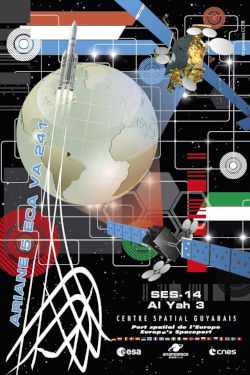
Ariane 5 is a European heavy-lift space launch vehicle developed and operated by Arianespace for the European Space Agency (ESA). It is launched from the Centre Spatial Guyanais (CSG) in French Guiana. It has been used to deliver payloads into geostationary transfer orbit (GTO) or low Earth orbit (LEO). The launch vehicle had a streak of 82 consecutive successful launches between 9 April 2003 and 12 December 2017. Since 2014, Ariane 6, a direct successor system, is in development.

Arianespace SA is a French company founded in 1980 as the world's first commercial launch service provider. It undertakes the operation and marketing of the Ariane programme. The company offers a number of different launch vehicles: the heavy-lift Ariane 5 for dual launches to geostationary transfer orbit, the Soyuz-2 as a medium-lift alternative, and the solid-fueled Vega for lighter payloads.

The Guiana Space Centre, also called Europe's Spaceport, is a European spaceport to the northwest of Kourou in French Guiana, a region of France in South America. Kourou is located approximately 310 mi (500 km) north of the equator at a latitude of 5°. In operation since 1968, it is a suitable location for a spaceport because of its equatorial location and open sea to the east.
Nilesat 101 is an Egyptian owned geosynchronous communications satellite that was decommissioned in February 2013.
HYLAS is a British satellite in geostationary orbit. HYLAS, which is an acronym for Highly Adaptable Satellite, is a communications satellite and was launched by the European Ariane 5 launch vehicle from the Guyana Space Centre at Kourou in French Guiana. It is located at the orbital location of 33.5 degrees west and will provide new and innovative services including High Definition Television (HDTV) and interactive satellite delivered broadband services. The satellite will help address the issue of poor broadband coverage in many parts of Europe which have less developed ground infrastructure.
Optus D3 is an Australian geostationary communications satellite, which is operated by Optus and provides communications services to Australasia. D3 was the third Optus-D satellite to be launched. It is a 2,401-kilogram (5,293 lb) satellite, which was constructed by Orbital Sciences Corporation based on the Star-2.4 satellite bus, with the same configuration as the earlier Optus D2 satellite.
Türksat 2A, a.k.a. Eurasiasat 1, was a Turkish communications satellite as part of a project to form an instant network with two geosynchronous satellites that is supervised by the companies Türksat A.Ş. in Turkey and Eurasiasat SAM in Monaco.
JCSAT-RA, previously known as JCSAT-12, is a Japanese geostationary communications satellite, which is operated by SKY Perfect JSAT Group.
Eutelsat 113 West A, formerly Satmex-6, is a geostationary communications satellite which is operated by Eutelsat. Originally built for Mexico's Satmex, it was launched in 2006. The satellite was acquired by Eutelsat in its 2014 merger with Satmex, and renamed Eutelsat 113 West A in May. It is used to provide communications services to the Americas, Hawaii and the Caribbean.
Thaicom 5 was a geostationary communications satellite operated by Thaicom. It was used to provide communications services to Asia, Africa, Middle East, Americas, Europe and Australia.
Arabsat-5A is a Saudi Arabian communications satellite operated by Arabsat. It will be used to provide television, internet and telephone services to Arabia, Africa and Europe.
Hot Bird 7 was a communications satellite that lost in a launch failure in 2002. Intended for operation by Eutelsat, it was to have provided direct-to-home broadcasting services from geostationary orbit as part of Eutelsat's Hot Bird constellation at a longitude of 13° East. Hot Bird 7 was intended to replace the Hot Bird 3 satellite, which had been launched in 1997.
Yahsat 1A is a communications satellite constructed by EADS Astrium and Thales Alenia Space for Al Yah Satellite Communications Company (Yahsat). It was launched in April 2011 from Arianespace's Guiana Space Centre in Kourou French Guiana in a dual payload launch with Intelsat New Dawn atop an Ariane 5 ECA rocket. Yahsat Y1A is based on the Eurostar E3000 satellite bus and had a launch mass of about 6000 kg. It is intended to provide Ku, Ka and C-band communications to the Middle East, Africa, Europe and Southwest Asia. It is in geosynchronous orbit at 52.5 degrees East.
HYLAS 2 is a geostationary High throughput satellite operated by Avanti Communications. HYLAS, an acronym for Highly Adaptable Satellite, was launched on an Ariane 5 from Guyana Space Centre at Kourou, French Guiana, on August 2, 2012.
Eutelsat 21B, previously known as Eutelsat W6A, is a French communications satellite. Operated by Eutelsat, it provides direct to home broadcasting services from geostationary orbit at a longitude of 21.5 degrees east. It replaced the Eutelsat 21A spacecraft which was launched in 1999.
Eutelsat I F-1, also known as European Communications Satellite 1 (ECS-1) is a decommissioned communications satellite operated by the European Telecommunications Satellite Organisation (Eutelsat). Launched in 1983, it was operated in geostationary orbit at a longitude of 13° East, before moving to several other locations later in its operational life, before it was finally decommissioned in 1996. It was the first of five satellites launched to form the first-generation Eutelsat constellation.
SaudiGeoSat 1/HellasSat 4, also known as SaudiGeoSat 1/HellasSat 4, is a Saudi and Greek geostationary communication satellite of King Abdulaziz City for Science and Technology (KACST) and HellasSat. It was built by Lockheed Martin and was launched on 5 February 2019 on board Ariane flight VA247.

Ariane flight VA241 was an Ariane 5 space launch that occurred from the Guiana Space Centre on 25 January 2018 at 22:20 UTC.



